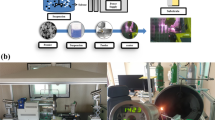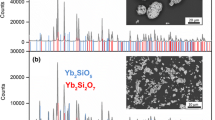Abstract
Si-based ceramics (e.g., SiC and Si3N4) are known as promising high-temperature structural materials in various components where metals/alloys reached their ultimate performances (e.g., advanced gas turbine engines and structural components of future hypersonic vehicles). To alleviate the surface recession that Si-based ceramics undergo in a high-temperature environmental attack (e.g., H2O vapor), appropriate refractory oxides are engineered to serve as environmental barrier coatings (EBCs). The current state-of-the-art EBCs multilayer system comprises a silicon (Si) bond coat, mullite (3Al2O3·2SiO2) interlayer and (1 − x)BaO·xSrO·Al2O3·2SiO2, 0 ≤ x ≤ 1 (BSAS) top coat. In this article, the role of high-temperature exposure (1300 °C) performed in H2O vapor environment (for time intervals up to 500 h) on the elastic moduli of air plasma sprayed Si/mullite/BSAS layers deposited on SiC substrates was investigated via depth-sensing indentation. Laser-ultrasonics was employed to evaluate the E values of as-sprayed BSAS coatings as an attempt to validate the indentation results. Fully crystalline, crack-free, and near-crack-free as-sprayed EBCs were engineered under controlled deposition conditions. The absence of phase transformation and stability of the low elastic modulus values (e.g., ~60-70 GPa) retained by the BSAS top layers after harsh environmental exposure provides a plausible explanation for the almost crack-free coatings observed. The relationships between the measured elastic moduli of the EBCs and their microstructural behavior during the high-temperature exposure are discussed.







Similar content being viewed by others
References
K.N. Lee, D.S. Fox, J.I. Eldridge, D. Zhu, R.C. Robinson, N.P. Bansal, and R.A. Miller, Upper Temperature Limit of Environmental Barrier Coatings Based on Mullite and BSAS, J. Am. Ceram. Soc., 2003, 86(8), p 1299-1306
N.S. Jacobson, D.S. Fox, J.L. Smialek, E.J. Opila, C. Dellacorte, and K.N. Lee, Performance of Ceramics in Severe Environments, ASM Handbook—Corrosion: Materials, Vol. 13B. S.D. Cramer and B.S. Covino Jr., Eds., ASM International, Materials Park, OH, USA, 2005, p 565-577.
J. Kimmel, N. Miriyala, J. Price, K. More, P. Tortorelli, H. Eaton, G. Linsey, and E. Sun, Evaluation of CFCC Liners with EBC after Field Testing in a Gas Turbine, J. Eur. Ceram. Soc., 2002, 22, p 2769-2775
S. Latzel, R. Vaßen, and D. Stöver, New Environmental Barrier Coating System on Carbon-Fiber Reinforced Silicon Carbide Composites, J. Therm. Spray Tech., 2005, 14, p 268-272
K.N. Lee, D.S. Fox, and N.P. Bansal, Rare Earth Silicate Environmental Barrier Coatings for SiC/SiC Composites and Si3N4 Ceramics, J. Eur. Ceram. Soc., 2005, 25, p 1705-1715
E. Garcia, J. Mesquita-Guimarães, P. Miranzo, M.I. Osendi, Y. Wang, R.S. Lima, and C. Moreau, Mullite and Mullite/ZrO2-7wt.%Y2O3 Powders for Thermal Spraying of Environmental Barrier Coatings, J. Therm. Spray Technol., 2010, 19(1-2), p 286-293
D. E. Glass, Ceramic Matrix Composite (CMC) Thermal Protection Systems (TPS) and Hot Structures for Hypersonic Vehicles., 15th American Institute of Aeronautics and Astronautics (AIAA) Space Planes and Hypersonic Systems and Technologies Conference, PDF file #AIAA-2008-2682 at: http://ntrs.nasa.gov/archive/nasa/casi.ntrs.nasa.gov/20080017096_2008016802.pdf (October 12, 2009).
N.P. Bansal, Solid State Synthesis and Properties of Monoclinic Celsian, J. Mater. Sci., 1998, 33, p 4711-4715
J.I. Eldridge and K.N. Lee, Phase Evolution of BSAS in Environmental Barrier Coatings, Ceram. Eng. Sci. Proc., 2001, 22(4), p 383-390
T. Bhatia, H. Eaton, E. Sun et al., Advanced Environmental Barrier Coatings for SiC/SiC Composites, Proc. ASME Turbo Expo, 2005, 1, p 253-258
B.J. Harder and K.T. Faber, Transformation Kinetics in Plasma-Sprayed Barium- and Strontium-Doped Aluminosilicate, Scr. Mater., 2010, 62(5), p 282-285
B.J. Harder, J.D. Almer, C.M. Weyant et al., Residual Stress Analysis of Multilayer Environmental Barrier Coatings, J. Am. Ceram. Soc., 2009, 92(2), p 452-459
W.C. Oliver and G.M. Pharr, Measurement of Hardness and Elastic Modulus by Instrumented Indentation: Advances in Understanding and Refinements to Methodology, J. Mater. Res., 2004, 19(1), p 3-20
C. Bescond, S.E. Kruger, D. Lévesque, R.S. Lima, and B.R. Marple, In-situ Simultaneous Measurement of Thickness Elastic Moduli and Density of Thermal Sprayed WC-Co Coatings by Laser-Ultrasonics, J. Therm. Spray Technol., 2007, 16(2), p 238-244
A.A. Elmustafaa and D.S. Stone, Nanoindentation and the Indentation Size Effect: Kinetics of Deformation and Strain Gradient Plasticity, J. Mech. Phys. Solids, 2003, 51, p 357-381
B.-K. Jang, Influence of Low Indentation Load on Young’s Modulus and Hardness of 4 mol% Y2O3-ZrO2 by Nanoindentation, J. Alloy Compd., 2006, 426, p 312-315
S. Sampath, X.Y. Jiang, J. Matejicek, A.C. Leger, and A. Vardelle, Substrate Temperature Effects on Splat Formation, Microstructure Development and Properties of Plasma Sprayed Coatings Part I: Case Study for Partially Stabilized Zirconia, Mater. Sci. Eng. A, 1999, 272, p 181-188
B.R. Marple, R.S. Lima, C. Moreau, S.E. Kruger, L. Xie, and M.R. Dorfman, Yttria-Stabilized Zirconia Thermal Barriers Sprayed Using N2-H2 and Ar-H2 Plasmas: Influence of Processing and Heat Treatment on Coating Properties, J. Therm. Spray Technol., 2007, 16(5-6), p 791-797
Acknowledgments
The authors would like to acknowledge valuable technical support from the Surface Technology Group technical officers: J.-F. Alarie (metallographic preparation), S. Bélanger (plasma spraying), B. Harvey (EBC rig engineering), M. Lamontagne (thermal spray process monitoring) and M. Thibodeau (SEM characterization).
Author information
Authors and Affiliations
Corresponding author
Additional information
This article is an invited paper selected from presentations at the 2010 International Thermal Spray Conference and has been expanded from the original presentation. It is simultaneously published in Thermal Spray: Global Solutions for Future Applications, Proceedings of the 2010 International Thermal Spray Conference, Singapore, May 3-5, 2010, Basil R. Marple, Arvind Agarwal, Margaret M. Hyland, Yuk-Chiu Lau, Chang-Jiu Li, Rogerio S. Lima, and Ghislain Montavon, Ed., ASM International, Materials Park, OH, 2011.
Rights and permissions
About this article
Cite this article
Cojocaru, C.V., Kruger, S.E., Moreau, C. et al. Elastic Modulus Evolution and Behavior of Si/Mullite/BSAS-Based Environmental Barrier Coatings Exposed to High Temperature in Water Vapor Environment. J Therm Spray Tech 20, 92–99 (2011). https://doi.org/10.1007/s11666-010-9599-4
Received:
Revised:
Published:
Issue Date:
DOI: https://doi.org/10.1007/s11666-010-9599-4




